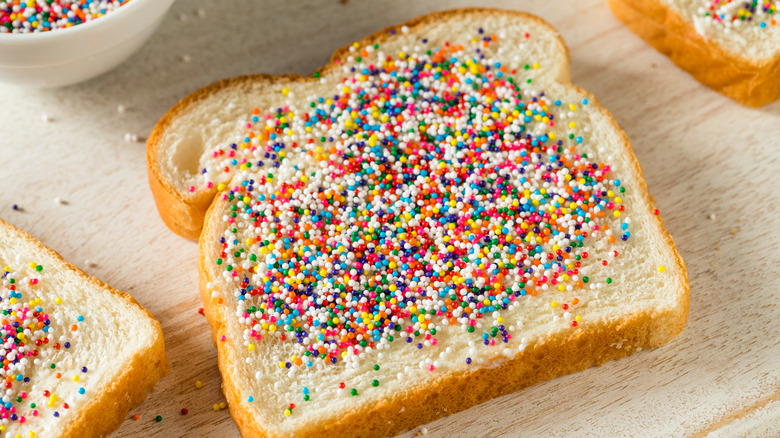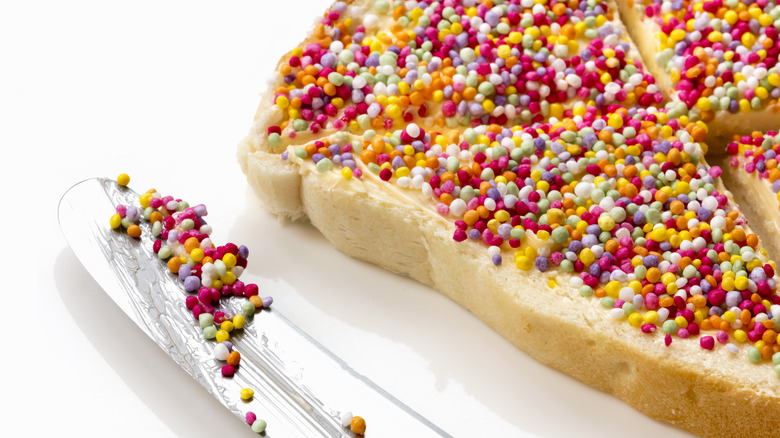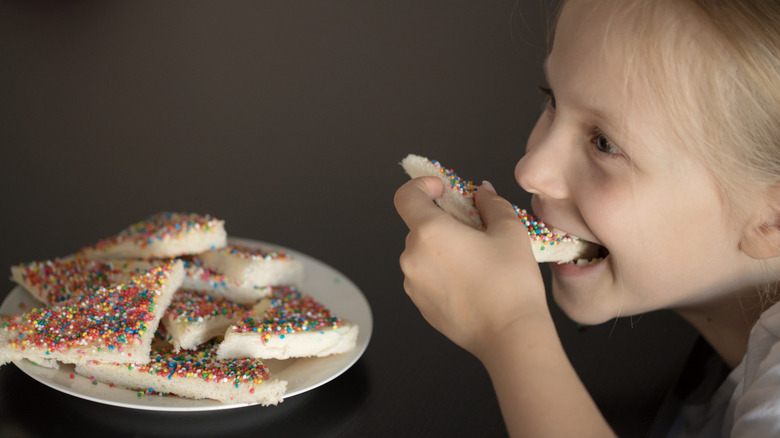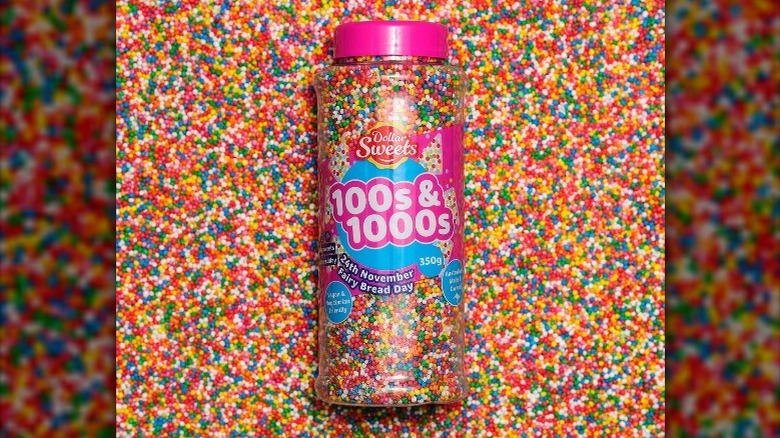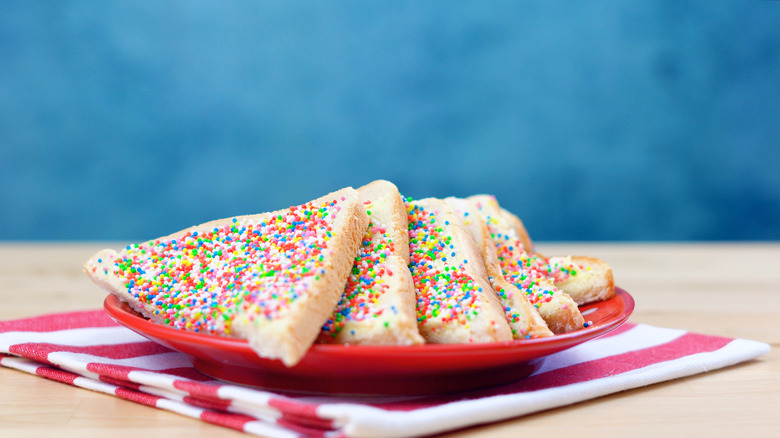Australian Fairy Bread Is A Whimsical Treat For All Ages
We may receive a commission on purchases made from links.
If fictional nanny extraordinaire Mary Poppins had landed in Sydney instead of London, it's a pretty sure bet her young charges would have dipped into fairy bread instead of the plain, old bread and butter they snacked on during high (flying) tea at Uncle Albert's house, via IMSDb. The whimsical and magical babysitter had more than one trick in her bag when it came to delighting kids while getting them to make good choices. Almost 60 years after the classic Disney movie's 1964 release, parents still tempt kids with a spoonful of sugar to help the medicine go down while recalling nostalgic moments from their childhoods. And Australian fairy bread is nothing if not nostalgic.
Australians consider fairy bread as something akin to a national treasure, a common thread connecting citizens across generations, per Independent Australia. It's a cross-cultural phenomenon rooted in childhood celebrations like birthday parties but equally welcome at grownup shindigs, where its presence among more sophisticated food offerings triggers a welcoming sense of nostalgia and levity.
What is fairy bread?
It seems almost too easy, but the recipe for one of Australia's most celebrated foods is about as simple as it can get. According to Epicurious, fairy bread is made from just three ingredients: bread, butter, and rainbow sprinkles. "Fairy bread is a basic food," Australian cookbook author and food blogger Lorraine Elliott told Epicurious. And it's important to get the right bread, which is not to suggest it's hard to find. "Don't use fancy bread unless you want to start a heated debate and get on the wrong side of Australians," Elliott advised. "Use the cheap, white loaf you buy at the supermarket for a dollar or two."
Then spread a thin layer of butter onto one side of each slice of bread. And even if it's tempting, don't go overboard. You'll want just enough butter to hold the next layer — rainbow sprinkles. And if you're a stickler for authenticity, be sure to get the right sprinkles. Australians swear by 100s & 1000s, a rainbow-colored, confetti-like confection. Finally, and this is important, cut the butter-and-candy-coated bread diagonally into four equal triangles.
Dueling origin stories
While the consensus among modern-day Australians is that fairy bread, in its simplest form, is a beloved, nostalgia-inducing snack, the question of its genesis remains a subject for debate. Some people adhere to the theory that it's the real-life version of a whimsical snack Robert Louis Stevenson cited in a poem from his 1885 collection, "A Child's Garden of Verse," via the Australian Food Timeline. In his poem "Fairy Bread," Stevenson wrote about children dining on fairy bread before settling in to share fairy stories.
Another theory put forth by Australian Food Timeline pegs the first reference to fairy bread in Australia to an April 1929 article in the "Hobart Mercury" describing the menu for a children's party at a local hospital. Others argue the snack's name has nothing to do with the rainbow sprinkles that give it whimsy, pointing to an early 20th-century teacake known as fairy bread. And an advice column in a circa-1920s Melbourne-area newspaper suggests fairy bread was initially a wafer-like toast served with soup.
The simple things
Regardless of theories of origin, fairy bread in its current incarnation remains firmly rooted in Australian food lore. Somewhere along the line, someone likely decided to jazz up simple bread and butter by adding a layer of colored sugar. Australian Food Timeline pegged the widespread adoption of that life-altering innovation to the 1920s when Australian confectionery Plaistowe & Company advertised the fairy bread as a kid-friendly combination of bread, butter, and their very own multi-colored nonpareils. A marketing initiative? Sure. But it was a hit. A few years later, in 1935, the "Sydney Morning Herald" solidified fairy bread's place in popular culture when a reporter referenced it as the perfect Christmas Day treat for children.
Even celebrity chef Curtis Stone has fond memories of eating fairy bread as a child. And despite his award-winning culinary chops, including a Michelin star (via the Institute of Culinary Education), Stone wouldn't ever consider messing with perfection. "I don't think there is any way you can really fancy up fairy bread," he told TODAY. "I can¹t imagine eating sprinkles on, say, a nice loaf of sourdough. I think the softness and fluffiness of the white bread contrasting against the gentle sugary crunch of the sprinkles is what it is all about."
An international incident?
While minor variations persist — margarine or butter? Crust or no crust? — the consensus is to keep it simple. That may be why an American food blogger nearly caused an international incident recently when they shared tips for "elevating" Australia's beloved bread. Culinary ace Megan Jane de Paulo via Independent Australia quickly seized on the since-updated post noting, "This U.S.-based site has dared to throw some sprinkles on toasted jam and bread with freaking mascarpone cheese and call it "fancy" fairy bread. Not just bread, but some Frankensteinian concoction with hidden vegetables. This outrageous offering comes from a nation that has cheese in a can and marshmallows in salad. Our reaction can only be one of shock and indignation."
Recapping its long-held status as a basic, kid-friendly snack made with three simple ingredients, Independent Australia reminded readers the beauty of fairy bread is "cheap ingredients which come together in sugary, sweet harmony." And while weighing in with barely a shoulder shrug on the crust-versus-no-crust debate, Jane de Paulo made one point crystal clear. "Fairy bread must be cut into four triangles. This is a fairy bread rule that can't be breached."
